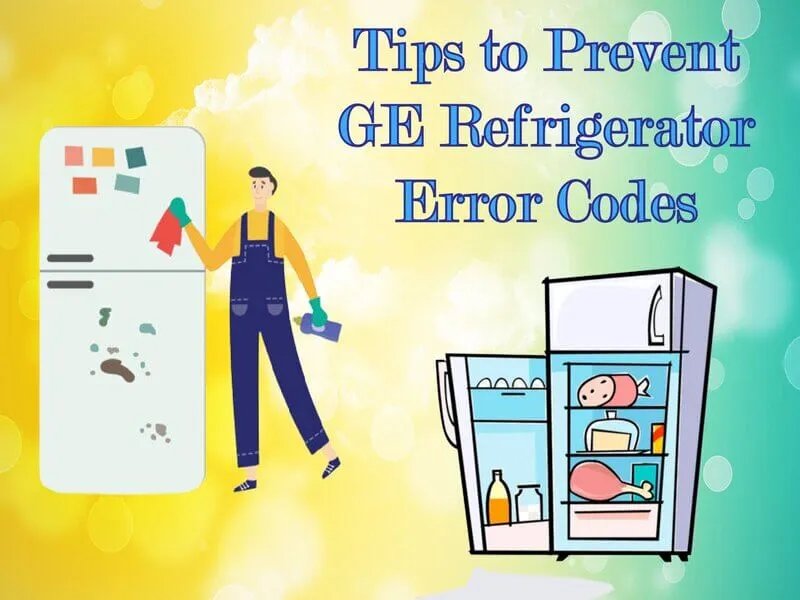
Understanding your refrigerator’s error codes can feel a bit like decoding a secret language. The ‘E1’ code in particular relates to issues with the temperature sensor or a malfunction in the control board. These complex-sounding terms just mean that the fridge is struggling to keep things cool because it can’t ‘talk’ properly to its parts. Think of it like this: If your thermostat at home couldn’t read the room temperature, your heating or cooling system wouldn’t know when to kick in. Similarly, when your GE refrigerator displays an ‘E1’ error, it’s like that confusion in your air conditioning system but inside your fridge. Fortunately, there are steps you can take to avoid bumping into this problem in the future.
Understanding the Causes of Error Code E1
To tackle prevention, we first need to understand what causes the dreaded error code E1. Typically, this issue arises from a faulty temperature sensor or a miscommunication with the control board. The temperature sensor is like the ‘ears’ of your fridge, listening to how warm or cold it feels inside. If this tiny part fails, it might send incorrect information — or none at all — to the control board, which is like the ‘brain’ of the refrigerator. Imagine if your GPS couldn’t tell where you are; you’d be lost, right? That’s what happens to your fridge when these parts don’t sync up.
Sometimes, environmental factors can contribute to these issues. Dust and dirt can build up on the internal components, blocking the sensors from doing their job correctly. It’s similar to when your air vents at home get clogged with dust — airflow is restricted, and efficiency drops. Regular cleaning of the fridge’s interior and keeping the area around it tidy can significantly reduce these chances.
Furthermore, power surges are another culprit. These sudden spikes in electricity flow can ‘shock’ the control board, causing it to malfunction. It’s like when you overload a circuit in your house, and the lights flicker because they can’t handle the excess power. Investing in a surge protector can safeguard the fridge from these unexpected electrical bursts, keeping it running smoothly.
Steps to Prevent Future Error Code E1 Occurrences
Now that we’ve dissected why the error occurs, let’s shift gears to prevention. First and foremost, regular maintenance is your best friend. Just like you wouldn’t expect your car to run forever without a tune-up, your refrigerator benefits greatly from periodic checks. Set a reminder to inspect the back of your fridge every few months. Make sure dust hasn’t settled on the coils or behind the appliance, which could lead to overheating and sensor malfunctions.
Another proactive step is to check the seals around your refrigerator doors. If the seals are cracked or not closing properly, warm air can sneak in, causing the fridge to work harder than it should—a common precursor to sensor issues. It’s akin to leaving a window open in winter; your heating system would have to work overtime to keep the room warm. You can easily test this by closing the door on a piece of paper; if you can pull it out without resistance, it’s time to replace the seals.
Lastly, consider the location of your fridge. It should be away from heat sources like ovens or direct sunlight. These external heat sources can confuse the temperature sensors, leading to miscommunication with the control board. Think of it as leaving your phone in the sun; it overheats and doesn’t function properly. By ensuring your refrigerator is positioned ideally, you help it operate efficiently and error-free.
Additional Tips and Tricks for a Smooth-Running Refrigerator
While we’ve covered the essentials for preventing the E1 error, there are a few more tips to keep your appliance humming along nicely. Make it a habit to periodically check the temperature settings of your refrigerator. Sometimes adjustments made inadvertently by shuffling food can lead to settings that don’t match the optimal cooling conditions the appliance needs. Think of these settings as the dials on your radio — if they’re off, the music won’t sound right. Ensuring the temperatures are set correctly can help maintain internal harmony.
Moreover, always keep an ear out for unusual noises. Your fridge, much like a car, shouldn’t be clanking or hissing. Strange sounds are often early signals of internal issues. Catching these early can prevent minor problems from escalating into full-blown errors like the E1 code. In this sense, using your senses — sound in this case — can be a powerful tool in maintaining your appliance.
Finally, even with the best care, components can age and wear out. Establishing a relationship with a trusted appliance technician can be invaluable. They can provide insight and tune-ups that ensure all parts are in tip-top shape. It’s like having a trusted mechanic for your car; a little professional advice can go a long way in preventing future headaches.
In conclusion, preventing the GE refrigerator’s error code E1 is mostly about being proactive and paying attention to the little things. By understanding the causes, taking preventive steps, and keeping up with regular maintenance, you set your refrigerator up for success and peace of mind for yourself. Here’s to a future without those unwelcome error beeps, and to a fridge that’s always stocked and ready to serve!
